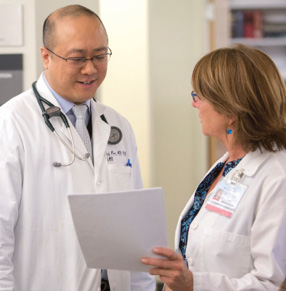
From bedside to bench
Grooming next generation clinician-researchers
Primo “Lucky” Lara is optimistic about the future of cancer research. As principal investigator of the Paul Calabresi Career Development Award for Clinical Oncology (K12), the professor of medicine and associate director of translational research at the UC Davis Comprehensive Cancer Center leads the selection committee that chooses bright young faculty members to pursue promising research. Awarded in 2011, the five-year $3.5 million grant is now funding the third group of young investigators.
“We look for junior faculty members who have a strong commitment to undertake clinically outstanding group of researchers who are poised to find cures for cancer.”
The Calabresi Award provides at least 75 percent protected time for the scholars to conduct cancer research. The program also offers a rigorous curriculum that includes training in a variety of essential research elements — from bench techniques in cancer molecular biology to designing clinical trials and analyzing data. Each investigator is assigned to both a clinical and basic science mentor, with an emphasis on rapidly turning findings into clinical applications.
“The program promotes learning and research results at a much faster pace than if the investigators were working on their own,” Lara says. “We are so fortunate that UC Davis has resources to provide such significant support for promising researchers at an early stage in their careers. It bodes well for the future of cancer diagnosis and treatment.”
The Calabresi Scholars
Tackling pancreatic cancer
Edward Kim, assistant professor of medicine and a gastrointestinal oncologist, is often frustrated by the treatment options available for his patients with pancreatic cancer.
“Pancreatic cancer is the only cancer with increasing mortality in both men and women,” says Kim. “No clinically significant advances have been made in novel agents to fight it in the last 15 years.”
He points out that although recent new treatment regimens — different combinations of standard drugs — have helped improve survival, they tend to have many side effects because of the cumulative toxicity of multiple drugs that are all designed to kill rapidly dividing cells, not just cancer cells.
“Combining standard drugs can be more effective but also compounds toxicity,” he says.
Kim is hopeful that this bleak picture will change soon. He is focusing on a protein called aurora kinase A expressed by cells during the cell cycle phase of mitosis. Because cancer cells express it in much greater numbers than do healthy cells, inhibiting aurora kinase A and thereby stopping cancer cell proliferation is a promising new approach for cancer therapy. In the laboratory, he is testing different potential partners to enhance the efficacy of aurora kinase A inhibition.
At the same time, Kim is involved in a phase I clinical trial testing an aurora kinase A inhibitor called alisertib. This trial, open to patients with any solid tumor, combines the standard chemotherapy drug gemcitabine with escalating doses of alisertib and is designed to establish the maximum tolerated dosage of the new drug. Once the dosage is determined, patients with pancreatic cancer will be specifically recruited to evaluate efficacy. It is anticipated that the two drugs in combination will work synergistically, with greater effects but lower toxicity than standard combination therapy.
“Pancreatic cancer is notoriously difficult to treat,” says Kim. “That’s what attracts me — there’s the opportunity to really make a significant impact.”
Recruiting immune cells to fight solid tumors
Most people think of stem cells — the early undifferentiated cells that have the capability to grow into many cell types — as helpful cells in the developing fetus and the bone marrow of adults. But stem cells also exist in tumors, and many believe that they are the source of metastasis and relapse after treatment.
“Cancer stem cells appear to do the ‘dirty work’ for tumors,” says Robert Canter, associate professor of surgery and a Calabresi investigator. “And, unfortunately, chemotherapy and radiotherapy tend to leave them behind.”
Working with William Murphy, professor and acting chair of the Department of Dermatology, Canter is exploring immunotherapy to target stem cells in tumors. To do this, he is recruiting natural killer cells — a type of lymphocyte in the blood that when “activated” can recognize and destroy cancer cells. Immuno-therapy with natural killer cells has demonstrated success in the treatment of some blood cancers, but has been less effective against solid tumors because of the inability to deliver large enough numbers of activated cells against the tumors.
Canter’s work involves isolating natural killer cells from the blood of patients or donors, increasing their numbers and activating them so that they are primed to recognize and better attack cancer stem cells, and then infusing them back into the patient.
“The goal is that the expanded and activated population of natural killer cells will go in and more effectively fight the tumor, especially the cancer stem cells,” Canter says. “We hope that combining this technique with standard therapies will completely destroy solid tumors such as sarcomas.”
Canter expects to begin trials soon to test what they have learned from their laboratory findings. One will be in collaboration with the School of Veterinary Medicine, using dogs that develop sarcomas similar to those seen in people, especially in the pediatric population.
“While helping people’s pets, we expect to pave the way to start trials with children and adults,” Canter says. “This research offers a promising new approach that may be a game-changer in curing these hard-to-treat cancers.”
Personalizing cancer therapy
When it comes to cancer therapy one size does not fit all, says Jonathan Riess, assistant professor of medicine and a Calabresi Award recipient. His research interest is non-small cell lung cancer, which comprises about 85 percent of lung cancers. Riess is homing in on a special mutation of a protein called the epidermal growth factor receptor (EGFR), which is found in non-small cell lung cancers of about 10 percent of patients in the United States. EGFR controls a signaling pathway important for cell division; the mutation keeps the receptor in the “on” position, resulting in continuously active and dividing cells.
According to Riess, the new approach can be very successful in patients who have tumors with the EGFR mutation — until resistance develops. Why does this happen, and what to do then?
“The more we learn about cancer, the more we realize that you usually can’t be successful by treating everyone alike,” says Riess. “Cancer is a lot more complicated than that — it is different among individual patients and often changes in the same person.”
Working with David Gandara, professor of internal medicine and director of the thoracic oncology program, and others as his mentors, Riess is exploring these questions using unique mice models from Jackson Laboratory. The mice are specially developed to incorporate cancer cells taken from individual patients, so that experiments can be designed to study mechanisms of tumor growth and effectiveness of different therapies in a very patient-specific fashion. He is working to design clinical trials to find optimal combinations of targeted and standard therapies.
“I believe that a personalized approach to cancer therapy will be key to success,” Riess says. “The Calabresi award gives me dedicated time to really explore this promising avenue to fight cancer more effectively.”
Unraveling drug resistance
Thomas Semrad is fascinated by the phenomenon of tumors responding well to a therapy then, after a period of time, ignoring the killer drugs they’re being bombarded with.
“Why do drugs work, then stop working?” he asks. “It’s a problem common to many different cancers. I want to be able to put together a story to explain it.”
The assistant professor of medicine in hematology and oncology is focusing on angiogenesis — the ability of tumors to recruit the host’s blood supply for their own nourishment. Although several drugs are available that specifically inhibit aspects of tumor angiogenesis, cells often become resistant to these agents.
Semrad is involved in two ongoing clinical trials testing new anti-angiogenic drugs: one at UC Davis for patients with lung or colon cancer, and the other that involves five cancer centers across the United States for patients with kidney cancer. When a patient does well with a standard anti-angiogenic drug, then shows signs that treatment has stopped working — the tumor starts growing, or more tumors appear — Semrad steps in.
He obtains biopsy material from the tumor and compares it to a baseline biopsy sample taken from the patient when he or she was first diagnosed.
“What has changed?” he wonders, as he runs the samples through a battery of tests. Semrad is hopeful he will find signals common to a variety of cancers cells use to recruit blood vessels. Such signals could potentially be used as biomarkers to detect whether a patient’s tumor has become resistant to an anti-angiogenic agent and a different therapy is needed.
“I think that the way to help people is to target the process early and delay progression,” he says.
All the Calabresi Award investigators expressed abundant gratitude for the opportunity to pursue research in such a dedicated fashion and to work closely under high-caliber senior mentors.
“This kind of work requires a tremendous amount of resources, time, learning and organization,” Semrad says, echoing the words of all the award recipients. “Without a program like this that provides formal training and experience with talented mentors, how would we develop the next generation of researchers?”

